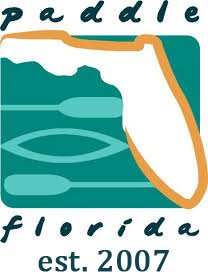The Chipola
By Doug Alderson
Excerpt from Florida’s Rivers: A Celebration of Over 40 of the Sunshine State’s Dynamic Waterways by Doug Alderson, published by Pineapple Press in 2021
The Chipola is one of those rivers that has a bit of everything—springs, bluffs, caves and mystery. Take the stretch where a defunct iron bridge crosses the river a few miles north of U.S. 90 near CR 162. The Bellamy Bridge—“Florida’s most haunted bridge”—can be reached by hiking a half-mile through an unspoiled floodplain forest.
The site has been used as a crossing spot for centuries and ghost stories abound, such as one about a headless wagon driver, a 19th century moonshine related murder victim, and the unsettled spirit of Elizabeth Jane Croom Bellamy, who died nearby of malaria in 1837. Hike the short access trail around sunset when the thick forest is darkening, cicadas begin whirring in treetops, barred owls start calling across the water, and a cold chill permeates the air…
Below Bellamy Bridge at Christoff Landing, you can paddle 4.5 miles to Florida Caverns State Park on a winding, canopied river that has numerous side springs, the largest being Baltzell Springs. County workers and state park rangers periodically try to clear snags in this section, but changing water levels and storm events—especially hurricanes such as Hurricane Michael in 2018—can produce snags that may require some negotiating. This section is wild and scenic with only a couple of houses. The state park is the only state park in Florida to offer dry cave tours, although occasionally the caves are closed during wet seasons due to partial flooding.
In the state park, the Chipola River disappears into a submerged cave for a quarter mile before reemerging on the surface, so the next access point is the Yancey Bridge below the state park. On river right about four miles down, the Ovens is a shallow cave at the base of a small bluff, the most consistently dry cave along a Florida river. Small side pockets off the main tunnel are reminiscent of clay ovens. Just deep enough to need a flashlight to explore, one might think the half-submerged boulders around the cave entrance were part of a Neolithic monument.
Just over a mile below the Ovens on river left is a narrow spring run that leads to Maund Spring, a lovely spot for a swim and picnic. Another good stopping point is the wider Spring Creek a couple of miles below on river left. The ever-clear Spring Creek is fed by several springs in the Merritt’s Mill Pond just north of U.S. 90. Numerous tubers utilize Spring Creek during the summer months.
Below the State Road 274 Bridge above Lamb Eddy Park, paddlers and boaters have fun running several shoals, including “Look-N-Tremble Falls,” a class one rapids. At times, people joke and call this the “Look-N-Giggle Falls,” but the shoals can vary in difficulty depending on water levels. Scouting is suggested. If the water is too low, portaging is advised since the limestone rocks can bang up your boat.
Just above Scott’s Ferry, the river winds through an impressive cypress forest and special care should be taken to follow the main channel. Below Scott’s Ferry, the river enters the ethereal looking Dead Lakes area. Dead Lakes was initially formed by natural sandbars along the Apalachicola River that backed up the river and caused many of the cypress trees to perish. Camping is permitted at the county-run Dead Lakes Park in Wewahitcka. A GPS unit is recommended for navigating in the Dead Lakes.
From the Dead Lakes, the Chipola Cutoff runs three miles through Wewahitchka to the Apalachicola River, but the official river flows 14 miles further to its natural confluence with the Apalachicola River. The Chipola contributes about 11 percent of the wide Apalachicola’s flow, the largest single contributor in the state. At the river’s confluence with the Apalachicola, it is another 26 miles to Apalachicola Bay.
The Chipola boasts 63 springs, more than any other Northwest Florida river, and it is known for its unique shoal bass. The water is generally clear at moderate to low water levels. At higher water levels, the water can be muddied by runoff. A trip down the Chipola is a memorable journey through rural north Florida with each segment offering unique experiences.
